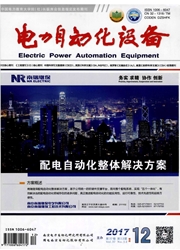

 中文摘要:
中文摘要:
从系统高频共模等效模型入手,分析确定产生共模电流的激励源;改进传统抑制共模电压空间矢量调制(SVM)算法,优化三相三电平车网互动(V2G)开关状态转换次序,形成五段式去冗余SVM算法,有效抑制共模电压,但三相三电平V2G中点电位不平衡会对共模电压产生影响,限制了共模电流抑制效果。提出了从控制算法和拓扑改进2条途径分别实现中点电位平衡的控制方法。采用控制算法途径时,引入虚拟空间矢量调制(NTV2),剔除输出共模电压幅值较大的冗余小矢量,保证了共模电流抑制效果;重新定义虚拟小矢量和虚拟中矢量,在新型虚拟矢量空间下,提出分区域的混合调制策略,使其开关频率固定,通过控制开关周期内的平均中线电流为零实现中点电位平衡。采用拓扑改进途径时,调制方式仍采用上述五段式去冗余算法,以抑制共模电流;在直流母线处引入H桥平衡电路(或与之等效的单桥平衡电路),根据中点电位的偏移方向,选择平衡电路工作模式来调整直流母线电容所带电荷量,从而抑制中点电位的偏移,并可设置电压误差滞环,进一步增强了该方法的普适性和鲁棒性。仿真实验验证了理论分析和2套协同控制策略的正确性。
 英文摘要:
英文摘要:
A high-frequency common-mode equivalent model is built to determine the common-mode voltage sources and the five-segment SVM(Space Vector Modulation) algorithm,an improved SVM algorithm with optimized switching sequence of three-phase three-level V2G(Vehicle-to-Grid) integration system and without redundant vectors,is proposed to effectively suppress the common-mode voltage. Since the neutral-point potential imbalance of V2 G system may limit the effect of common-mode current suppression,two control strategies are proposed to balance the neutral-point potential. In the strategy of control algorithm,the virtual space vector modulation(NTV2) is introduced to exclude the redundant small vectors with larger common-mode voltage outputs to guarantee the common-mode current suppression effect;virtual small vectors and virtual medium vectors are redefined to form a new virtual vector space,for which a mixed modulation strategy based on different small regions is proposed to fix the switching frequency;and the neutral-point potential is balanced by controlling the average neutral current to zero within one switching period. In the strategy of topology improvement,the five-segment SVM algorithm is applied to suppress the common-mode current;H-bridge(or equivalent single-bridge) balancing circuit is introduced at DC bus and its working mode is selected based on the offset direction of neutral-point potential to adjust the capacity of DC link capacitor for suppressing the neutral-point potential offset;and a voltage-error hysteresis loop may be set to further enhance the universality and robustness of this strategy. The correctness of theoretical analysis and the proposed two control strategies is verified by simulation and experiment.
 同期刊论文项目
同期刊论文项目
 同项目期刊论文
同项目期刊论文
 期刊信息
期刊信息
